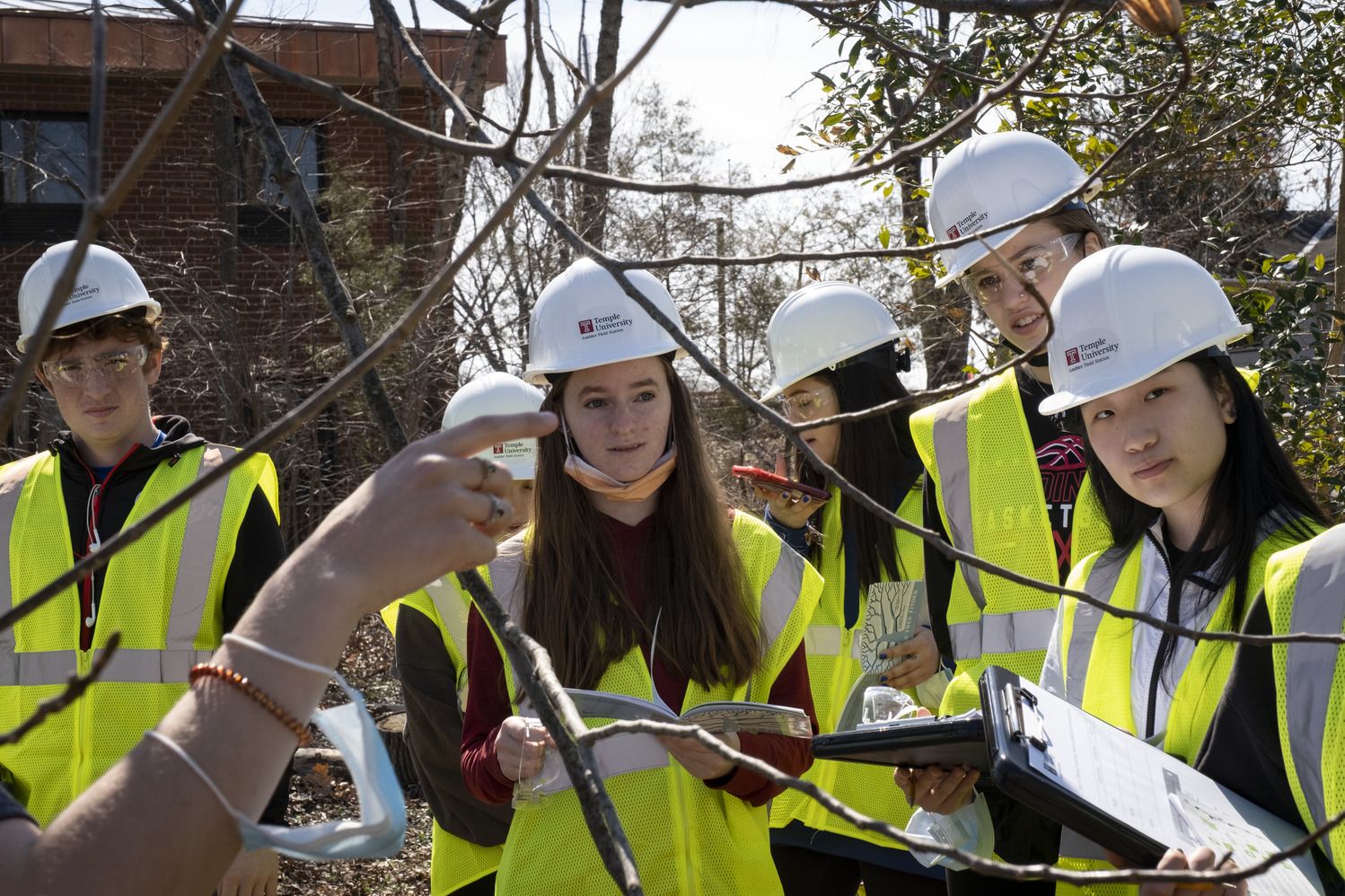The Ambler Field Station welcomes high school students through field research activities
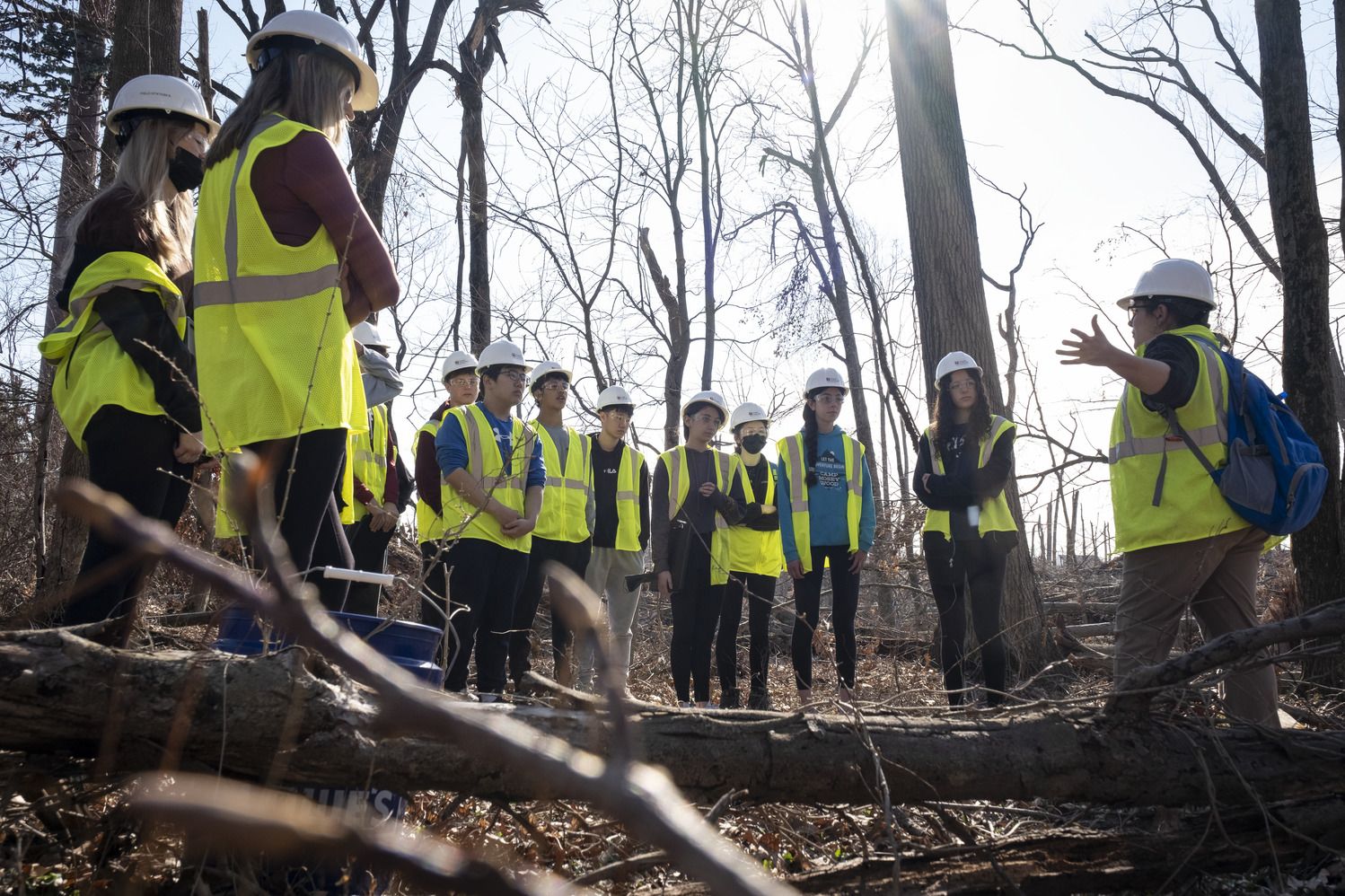
On March 16, a group of 42 Upper Dublin high school students put on safety jackets and safety glasses before adjusting their hard hats for a class trip at the Temple Ambler Field Station. The group was preparing to conduct research on the natural environment surrounding campus.
The students learned to adhere to the same protocols followed by researchers at the Field Station and even those on the international arena. The goal was to provide the students with the opportunity to be part of an actual research effort and collect data that would get incorporated into the Field Station’s databases.
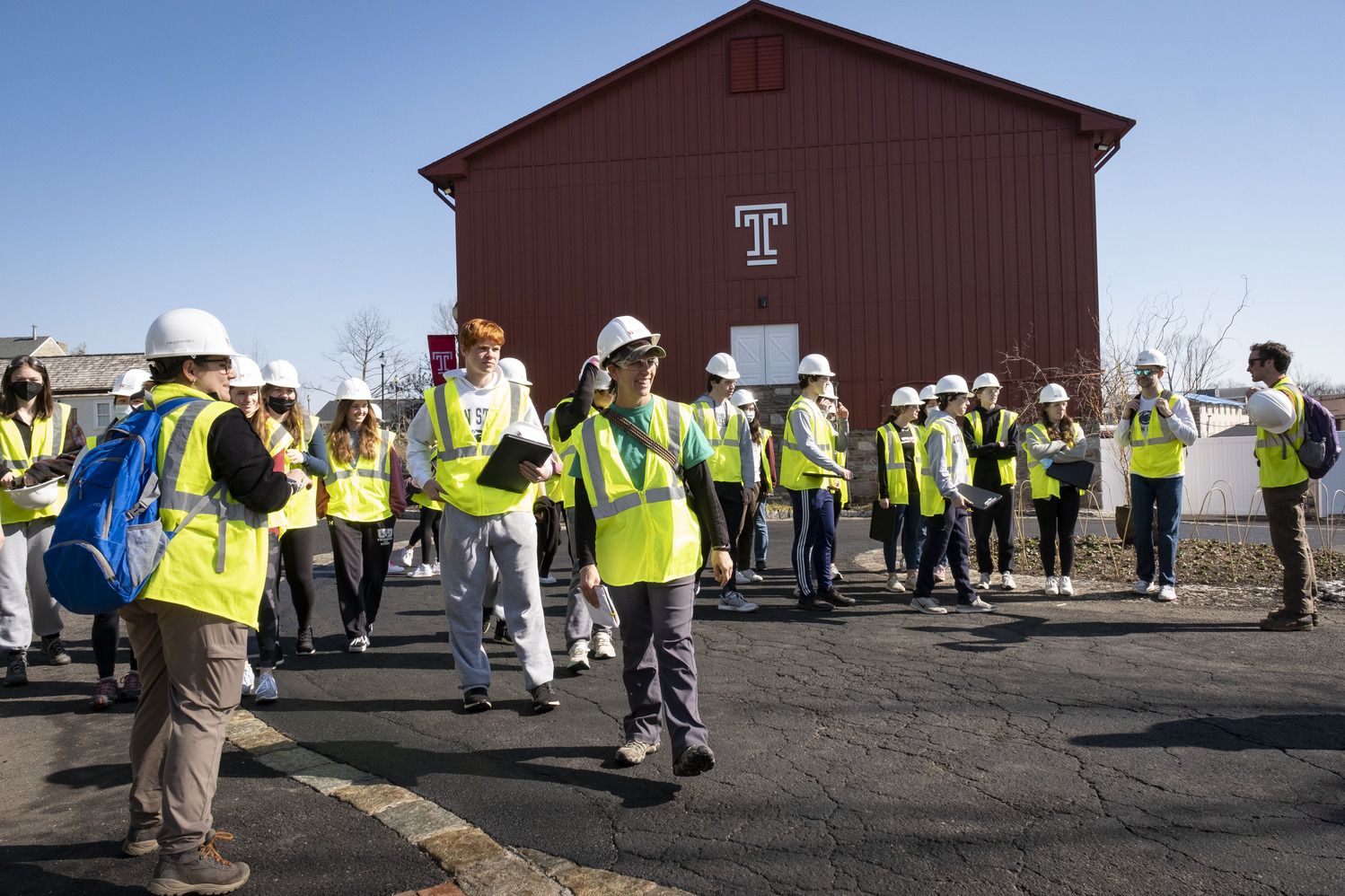
Amy Freestone, associate professor in the Department of Biology at Temple and the director of the Temple Ambler Field Station, explained that the station was created in 2020 as a collection of outdoor laboratories and living libraries used to study the natural world on Ambler’s campus.
“Our natural environments serve as a platform for research and educational opportunities, particularly for students who are interested in biology, ecology, environmental science and sustainability, to step into their textbooks and learn outside of the classroom setting,” said Freestone. “They get to train in forest science, ecology and invasive species, and immerse themselves in the ecosystems that they learn about in class and experience it firsthand.”
“Another one of our priorities is promoting diversity in the sciences, and we use our activities to advance that goal,” she added.
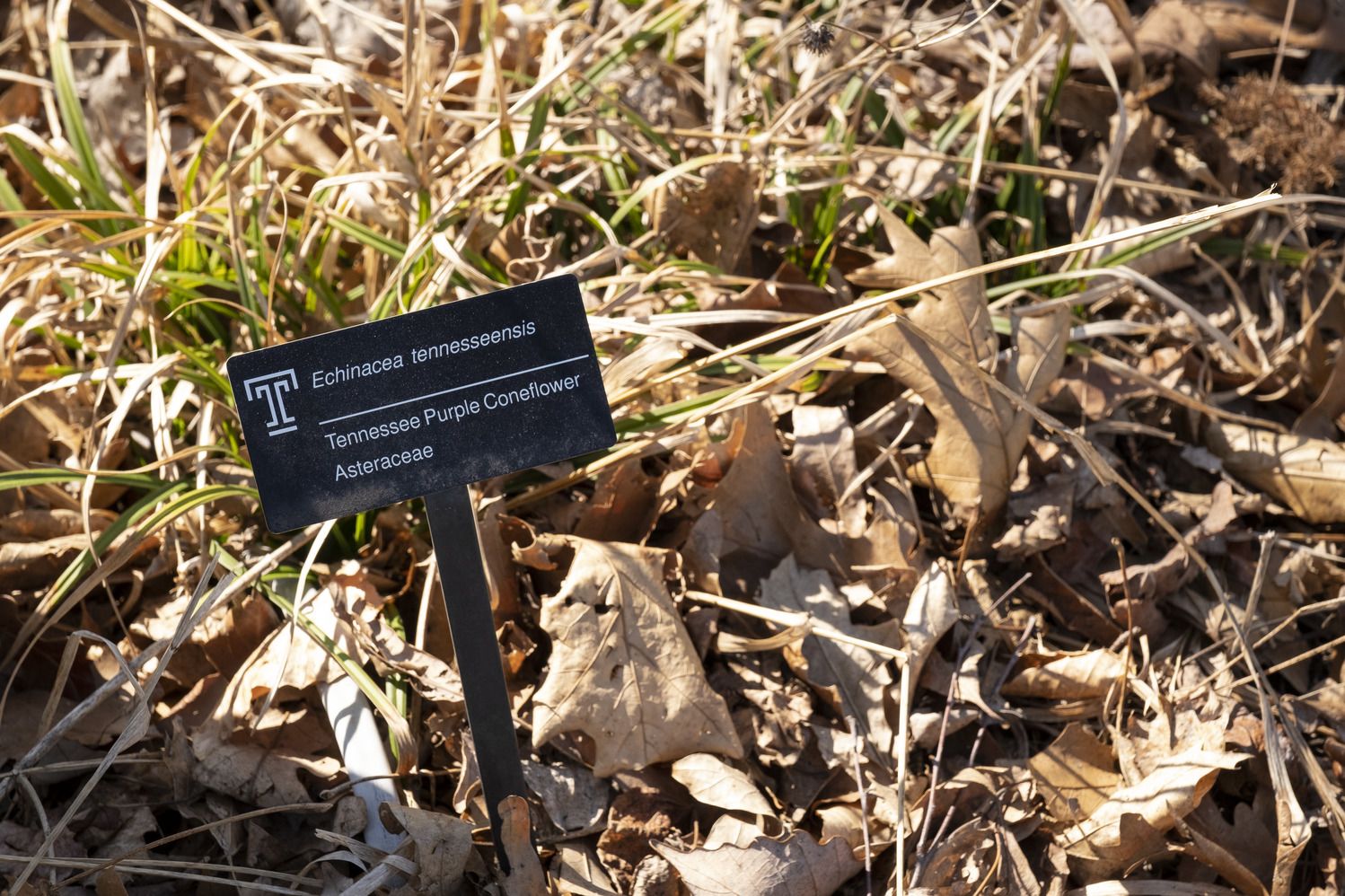
On the 187-acre area of the Temple Ambler Field Station and Ambler Arboretum, over 800 groups have been identified. Many species of trees and flowering plants are found in the designed gardens but also woodlands that are among the natural ecosystems that skirt the Temple Ambler campus area.
On the 187-acre area of the Temple Ambler Field Station and Ambler Arboretum, over 800 groups have been identified. Many species of trees and flowering plants are found in the designed gardens but also woodlands that are among the natural ecosystems that skirt the Temple Ambler campus area.
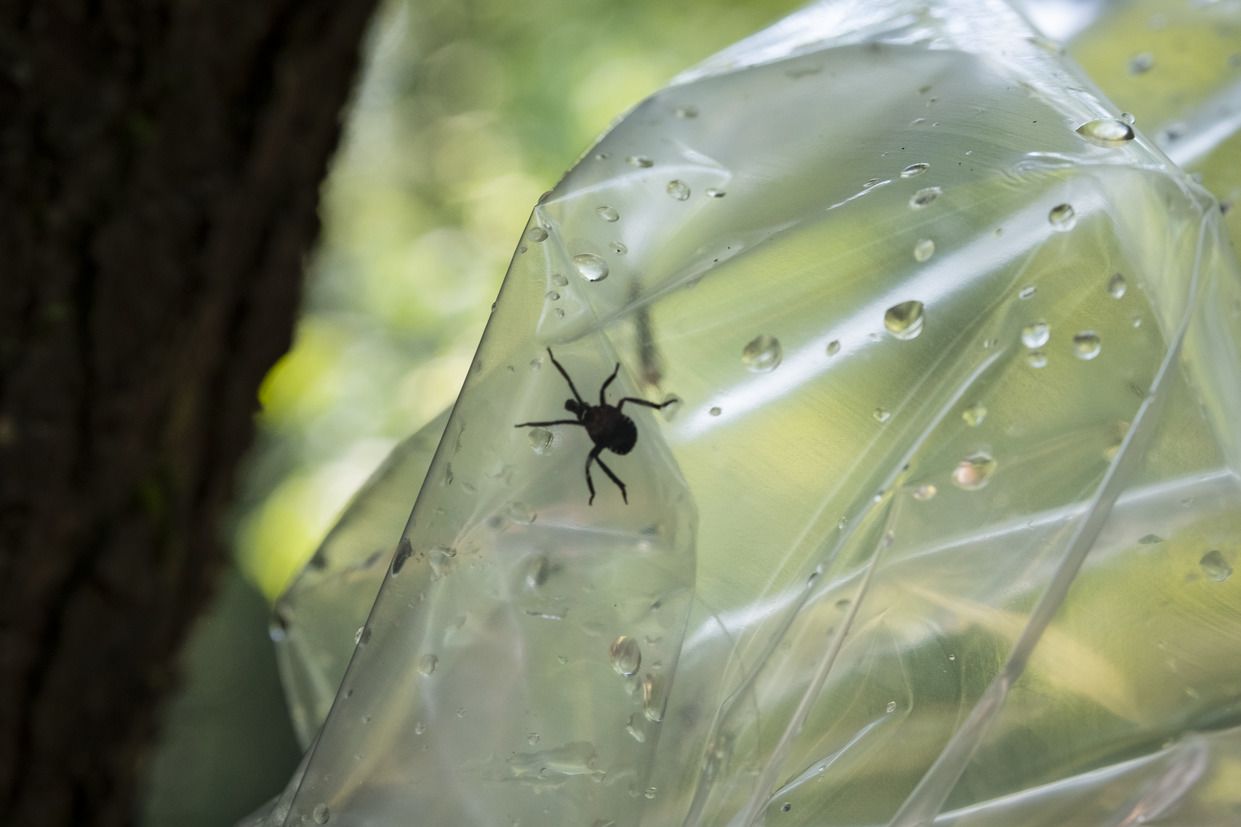
Students have assisted with understanding the invertebrate and vertebrate biodiversity at the Temple Forest Observatory. As well, they have been monitoring the activity of over 15 species of mammals, including white tail deer, red foxes, coyotes and birds on Ambler’s campus. And more than 50 species of spiders have been cataloged at Temple Ambler before and after the windstorm event on campus.
Students have assisted with understanding the invertebrate and vertebrate biodiversity at the Temple Forest Observatory. As well, they have been monitoring the activity of over 15 species of mammals, including white tail deer, red foxes, coyotes and birds on Ambler’s campus. And more than 50 species of spiders have been cataloged at Temple Ambler before and after the windstorm event on campus.
The AP environmental science students were separated into smaller groups, rotating to collect data at three stations that each included an facilitator. All the data collected from each station would be added to the Ambler Field Station’s database for use by researchers and other students.
Mariana Bonfim, CST ’21, assistant research professor in the Department of Biology at Temple and at the Ambler Field Station, said this event creates a unique opportunity for the next generation of students to get hands-on research experience and connect with nature.
“Temple University is the host of so many different natural ecosystems here at the Ambler Field Station. We have forests of various age structures, meadows, a stream, designed gardens and so much more,” said Bonfim. “So students not only learn hands-on in some of our field-based courses, or engage in research, but sometimes just come for a hike to make their own observations and have some Nature Rx moments.”
“We want to show them what scientists do to study the natural environmental impacts, so they get to perform the same protocols that researchers use to collect data in the field,” she added. “And we are integrating those kinds of practices into our internship program, coursework and education opportunities we offer.”
The high school visit to the Ambler Field Station’s three locations included the Temple Forest Observatory (TFO), the Bioblitz forest trails and focal trees where spotted lanternfly egg laying behavior takes place.
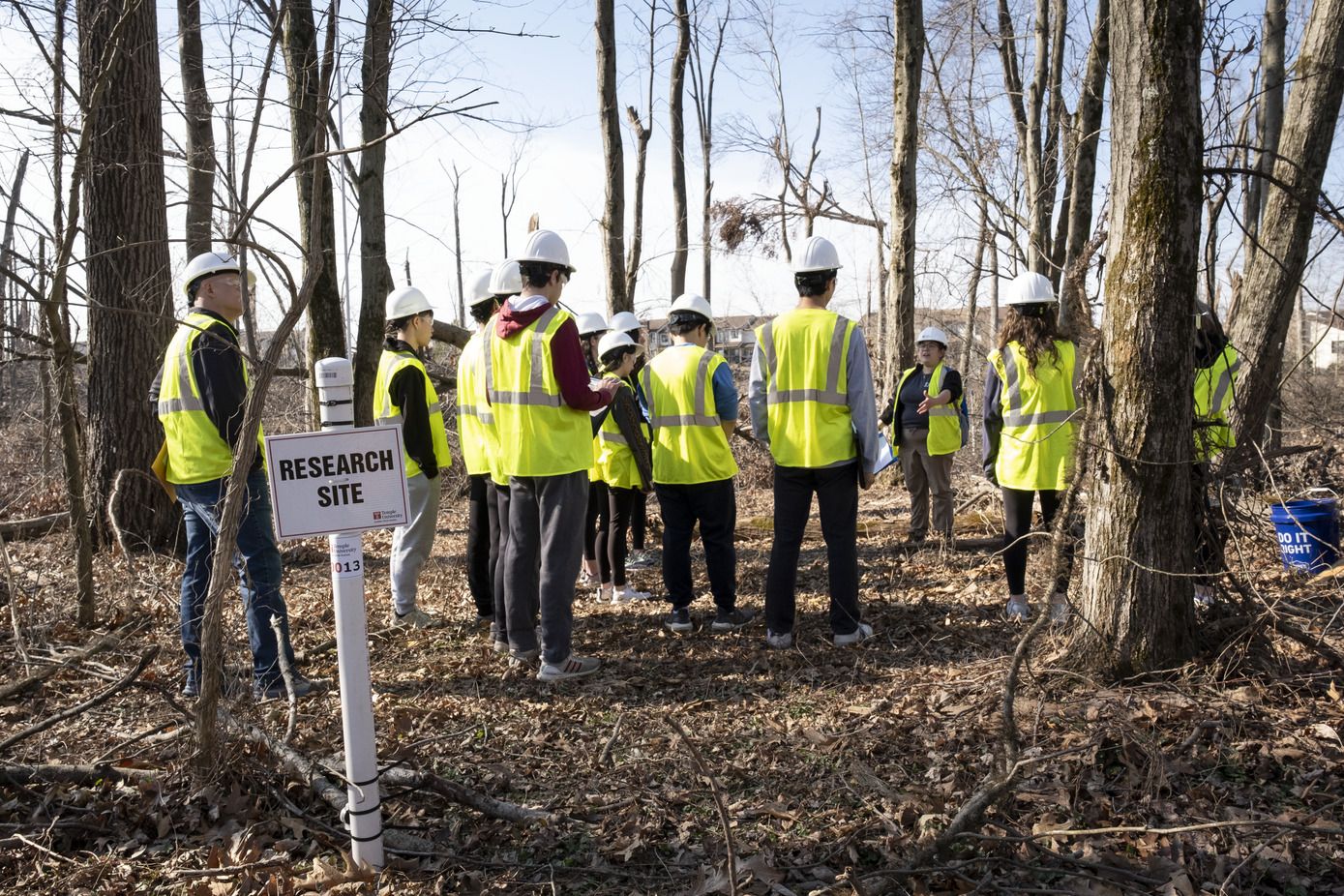
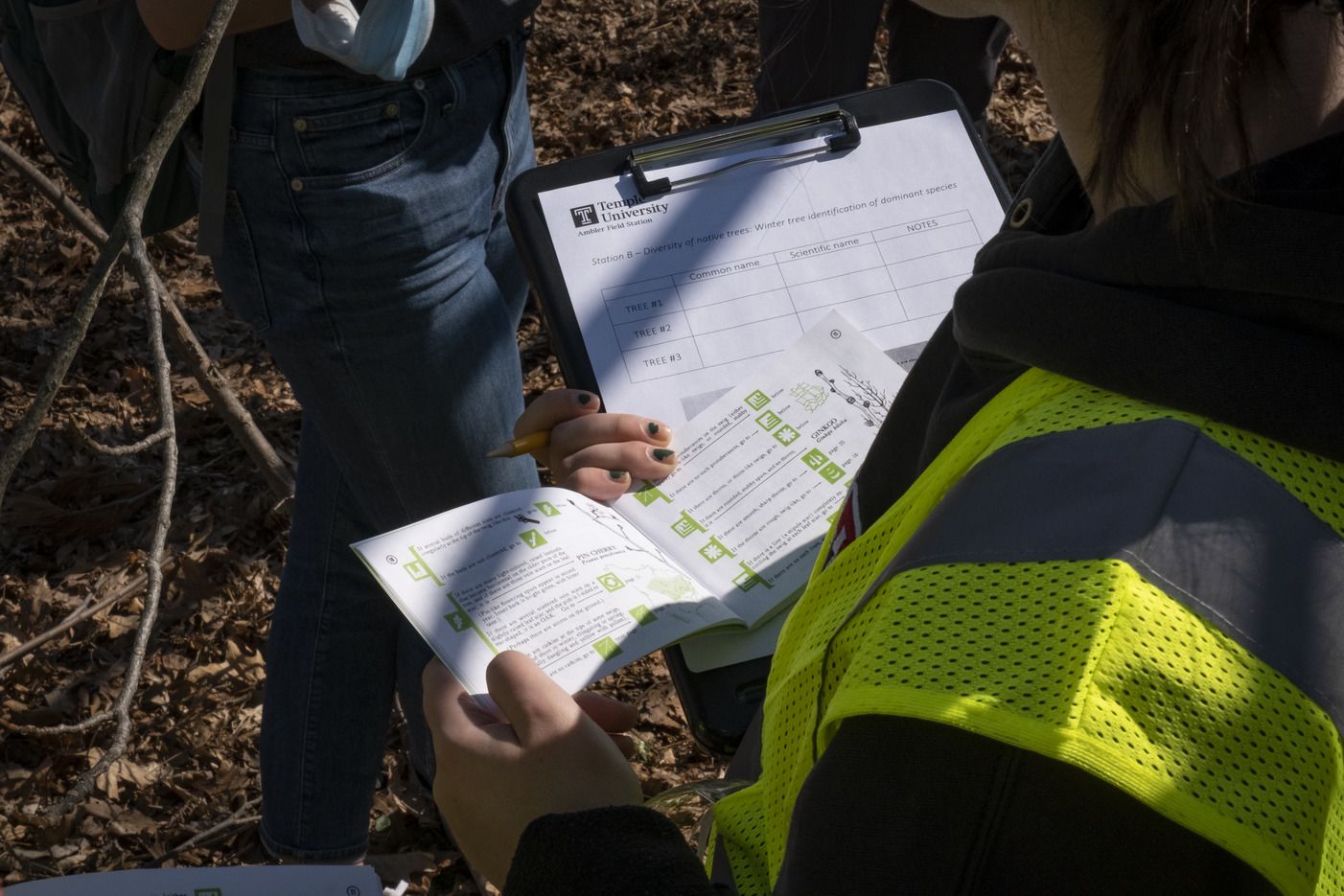
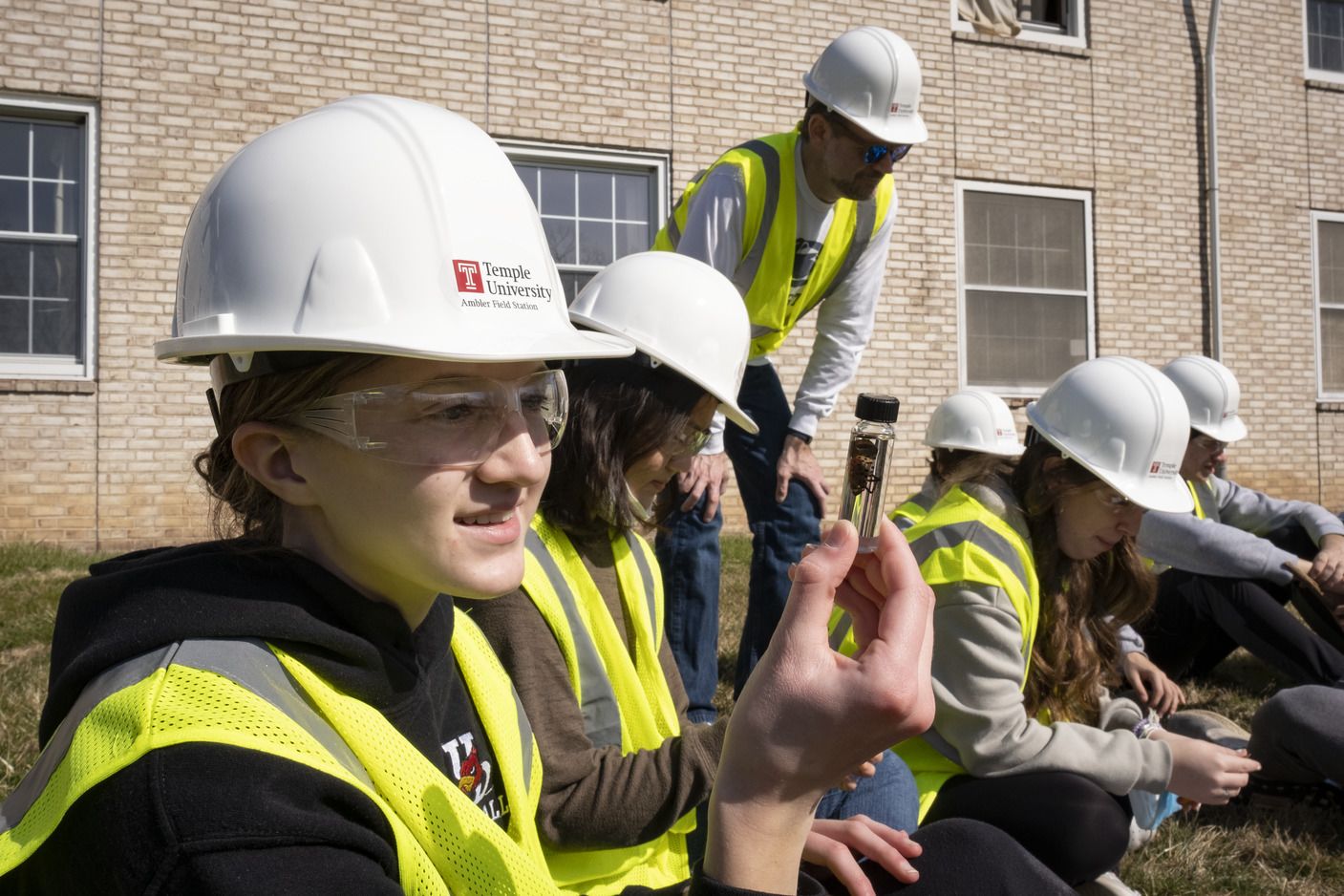
Temple Forest Observatory
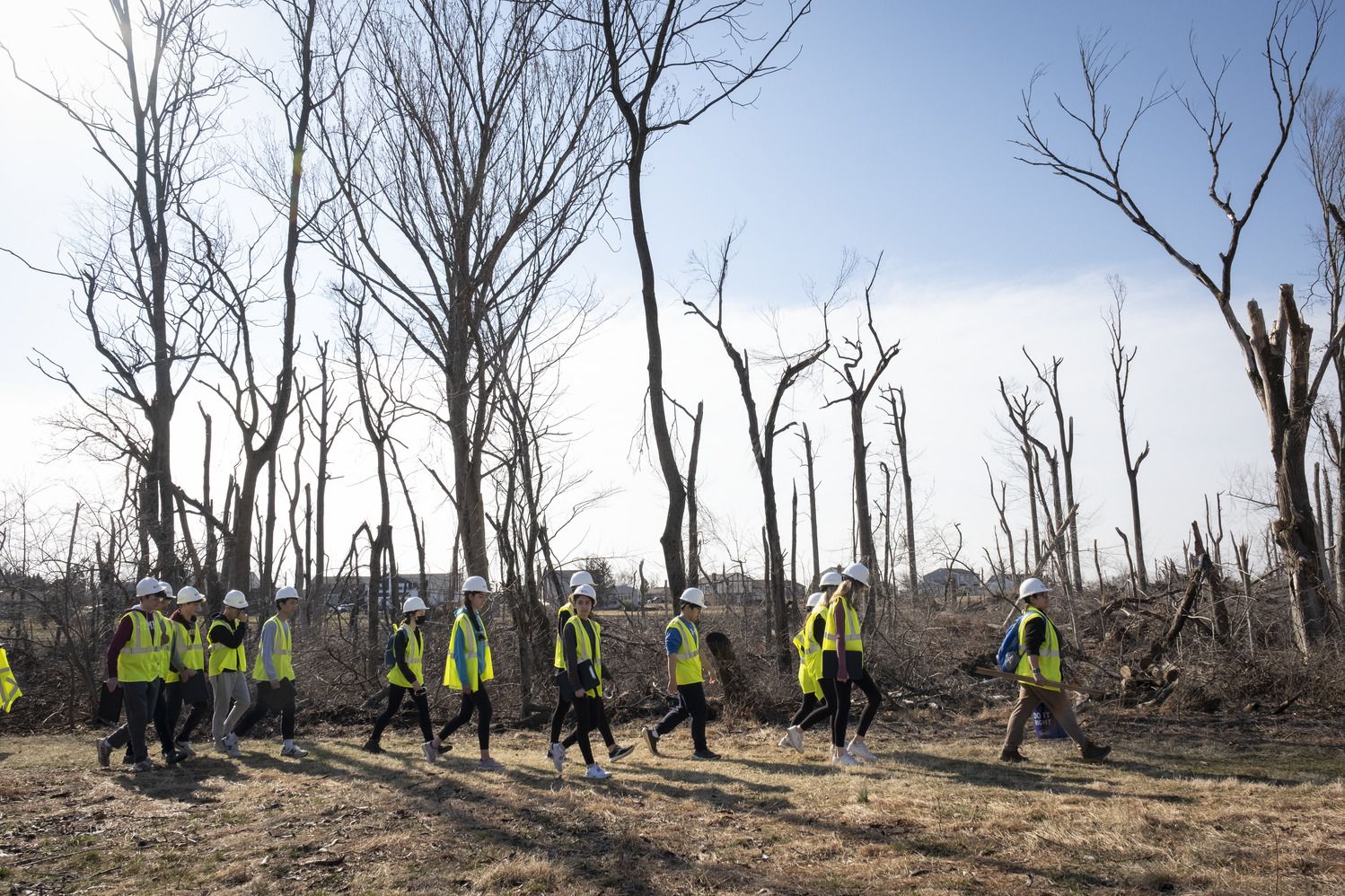
Temple Forest Observatory
Students collected data on the carbon storage of living trees and deadwood biomass in the Temple Forest Observatory’s research site. The students first measured the diameter and height/length of both the living trees and deadwood in the forest to be able to calculate the tree volume, dry biomass and carbon fraction. These protocols and calculations are important to understand carbon storage capacity of the forest, particularly after the tornado that impacted Temple Ambler last September.
Bonfim explained that forests are important carbon pools since trees, for instance, capture the carbon from the atmosphere into their tissues, thereby helping to mitigate the effects of climate change. She added that the frequency and intensity of natural disturbances are being altered by climate change, and that research on carbon storage capacity is used to understand how these disturbances, such as the tornado, impact natural ecosystems.
Freestone added that the researchers now have a special opportunity to observe the growth of the forest at Temple Ambler as it continues to recover from the ecological disturbance caused by the EF2-level tornado, a remnant from Hurricane Ida, that barreled through campus in September last year.
“The tornado provided a unique opportunity to study and teach lessons on the effects of climate change and the recovery of the forests right at our doorstep,” she said.
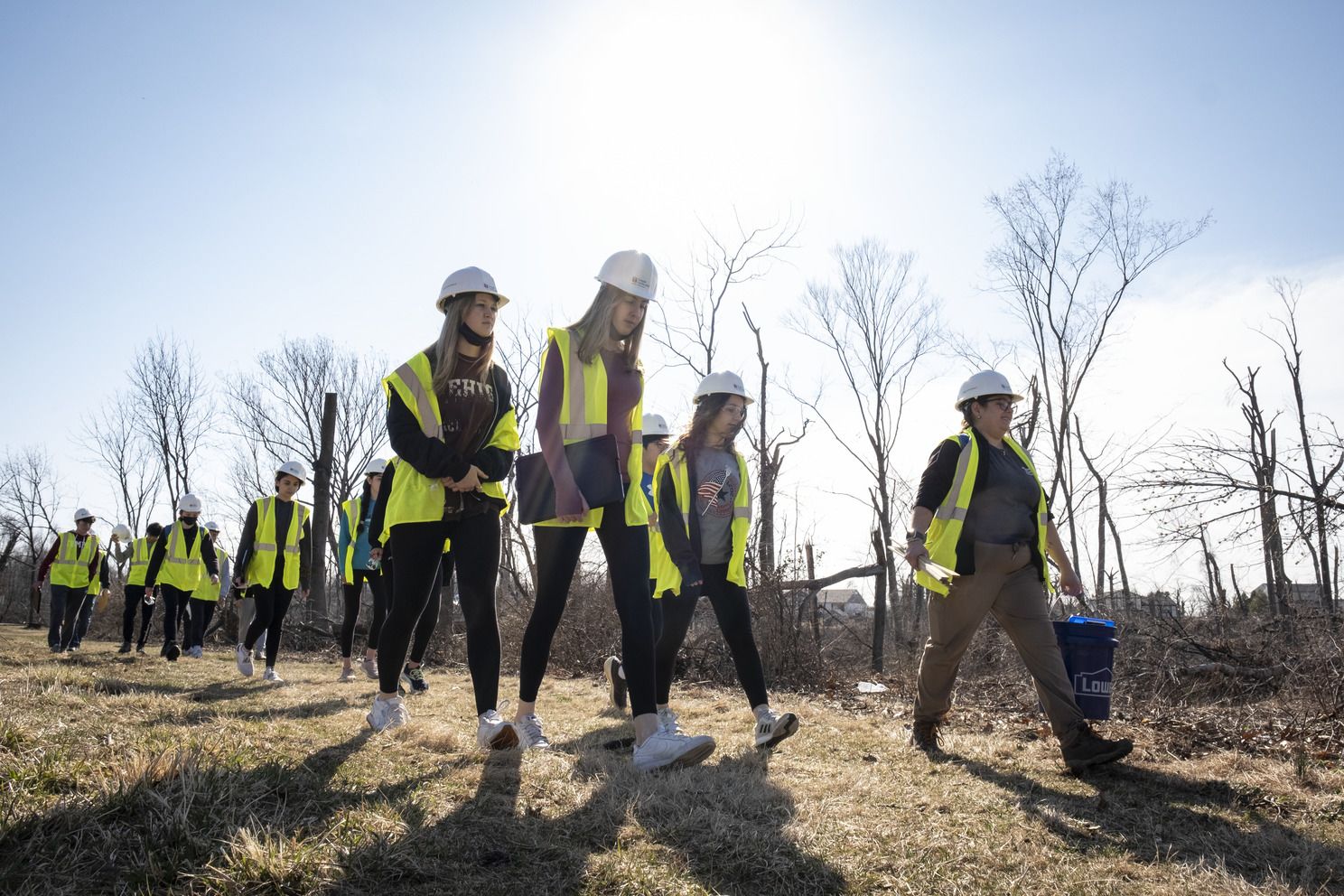
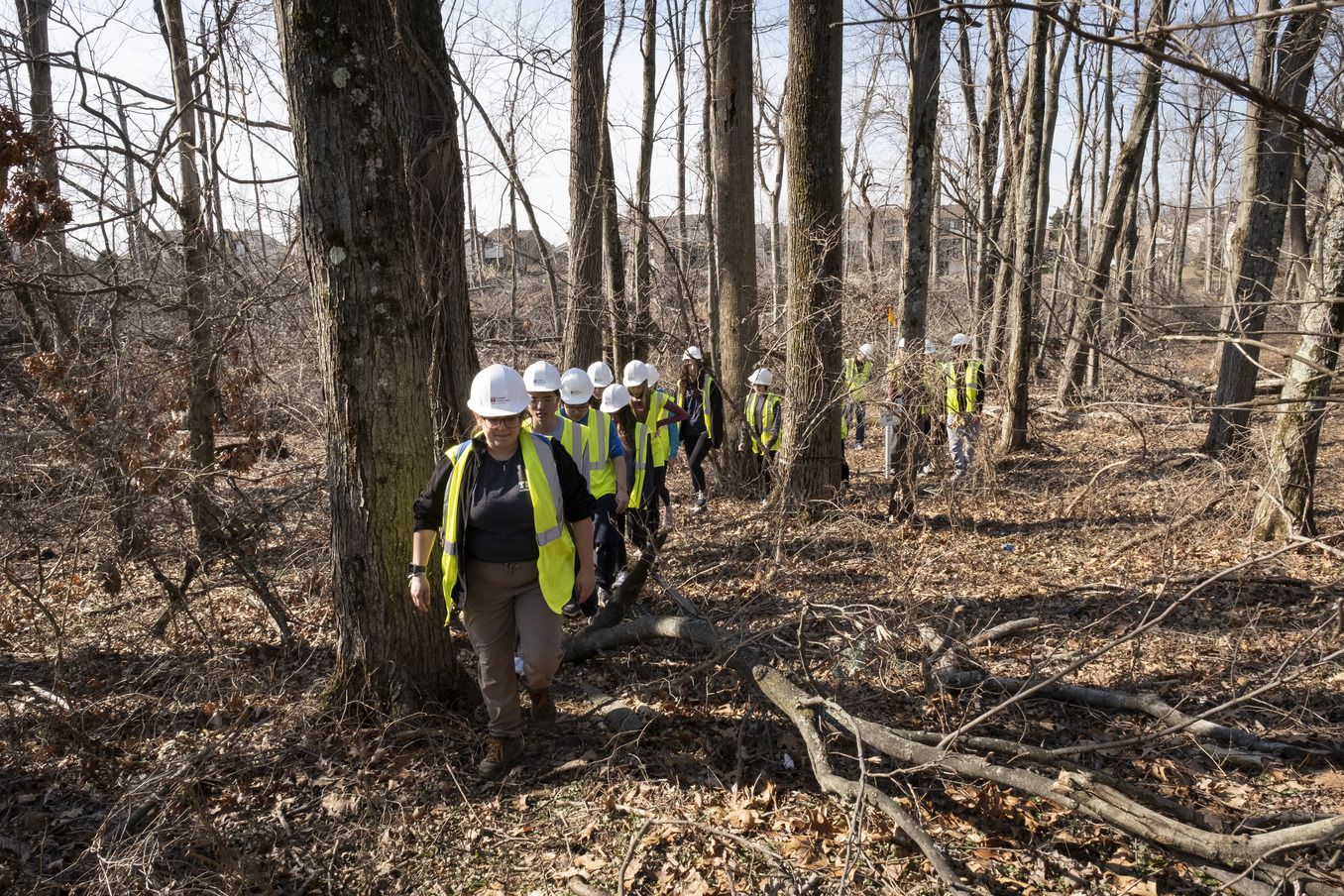
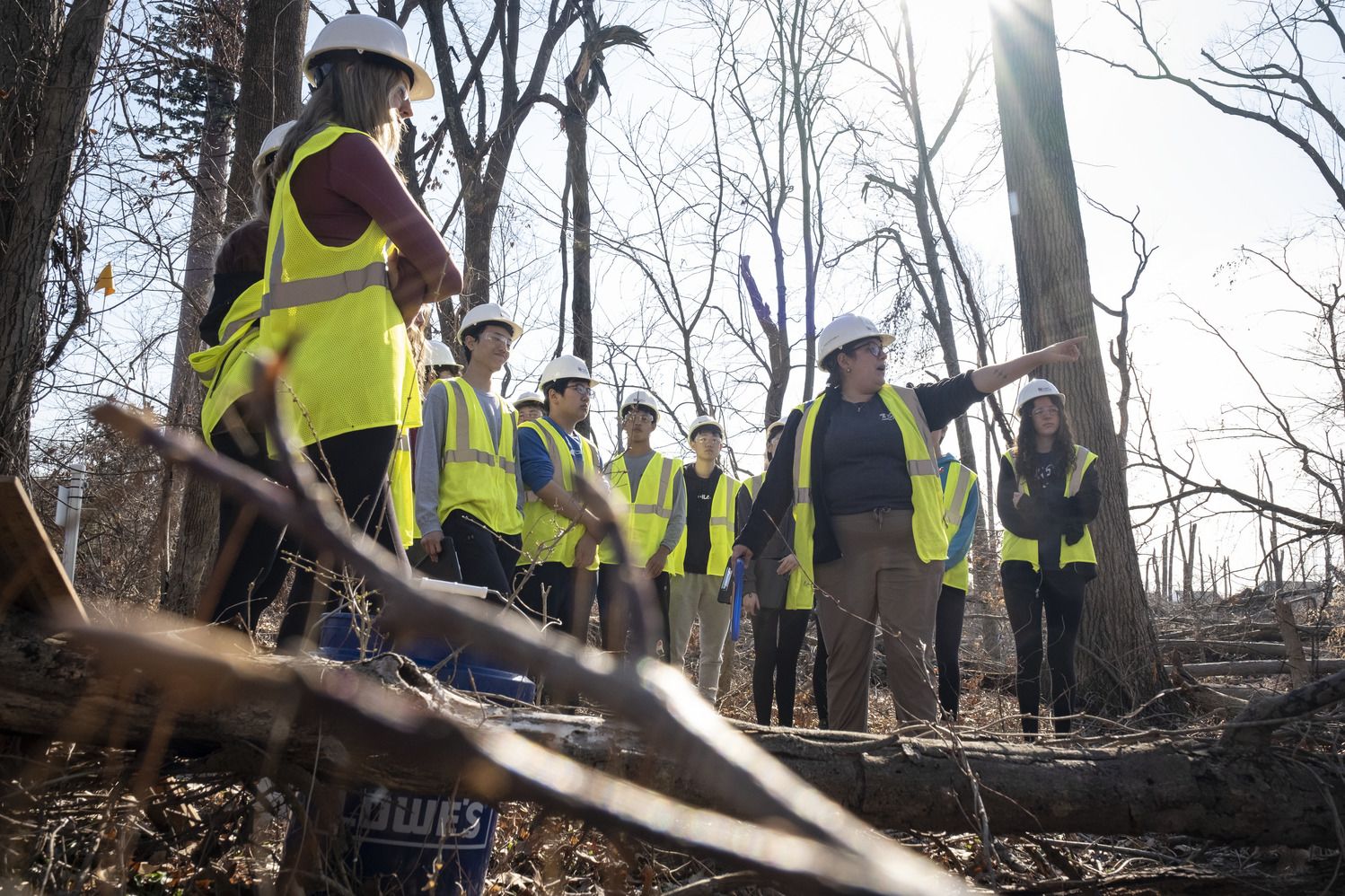
The Upper Dublin high school students gained hands-on experience by being fully immersed in the Temple Forest Observatory site with Mariana Bonfim, CST ’21, an assistant research professor in the Department of Biology and Ambler Field Station at Temple
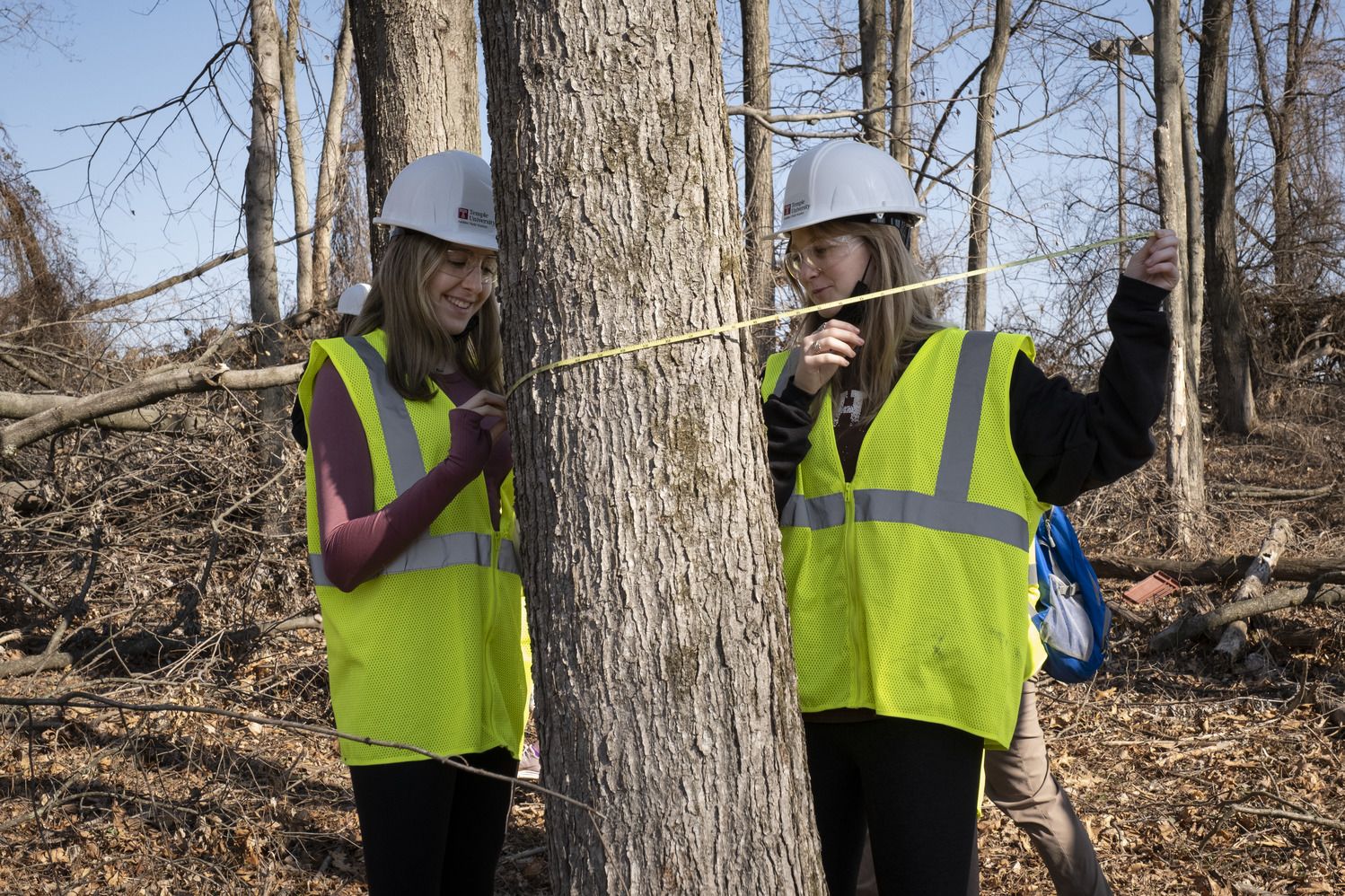
At the Temple Forest Observatory’s research site, students measure a tree with diameter tape at breast height which is a point around the trunk at four feet above the forest floor. Students have assisted in tagging, measuring and identifying over 4,800 woody plants that are at least four feet tall with a stem diameter bigger than a finger (1 cm).
At the Temple Forest Observatory’s research site, students measure a tree with diameter tape at breast height which is a point around the trunk at four feet above the forest floor. Students have assisted in tagging, measuring and identifying over 4,800 woody plants that are at least four feet tall with a stem diameter bigger than a finger (1 cm).
At the Temple Forest Observatory research site an identification tag had been attached to each tree and other woody plant before the tornado hit the Temple Ambler campus last September. As a result, researchers were able to catalog what was lost during the storm and assess how the tornado’s impact changed the natural dynamic of this forest community.
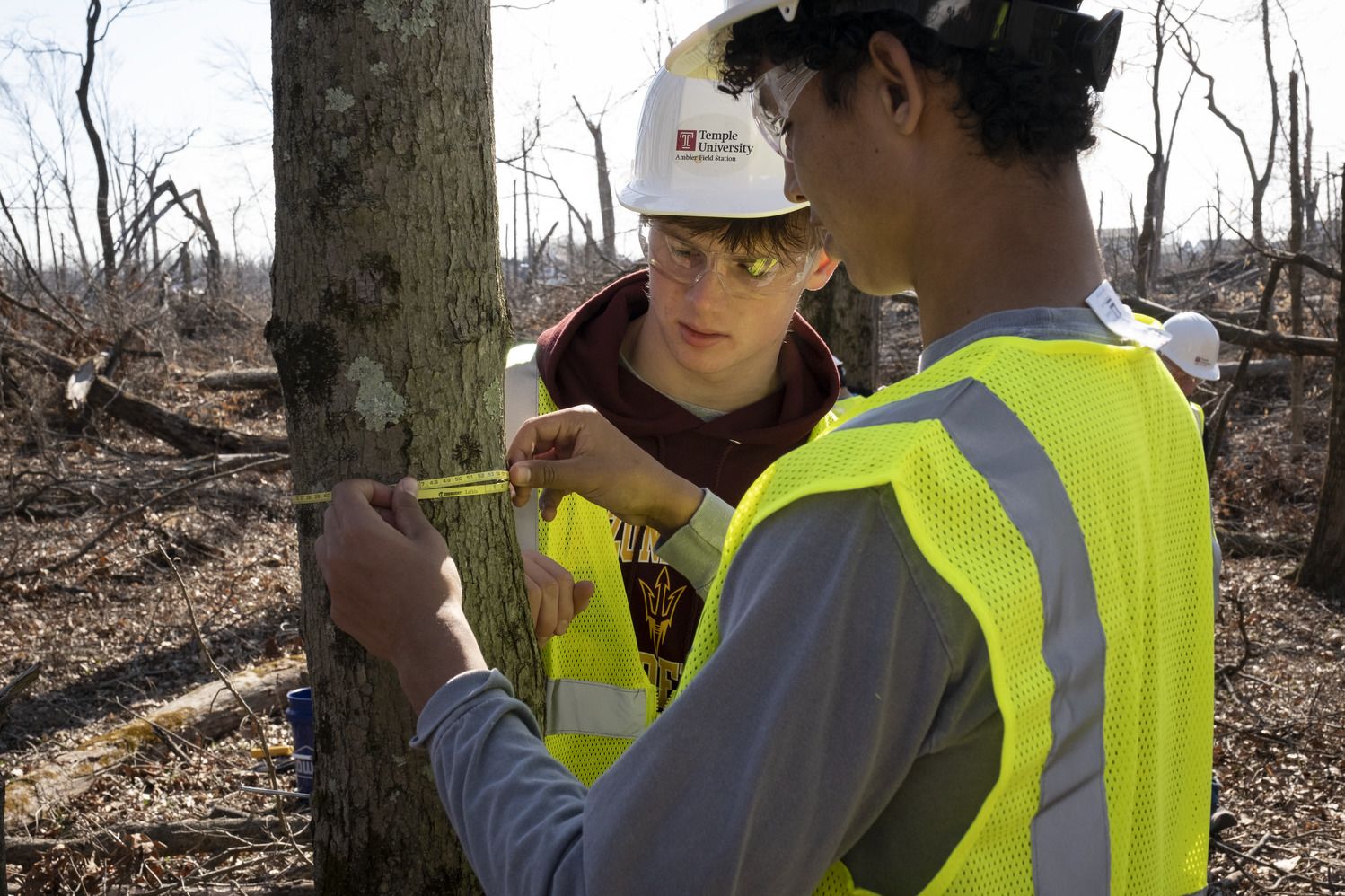
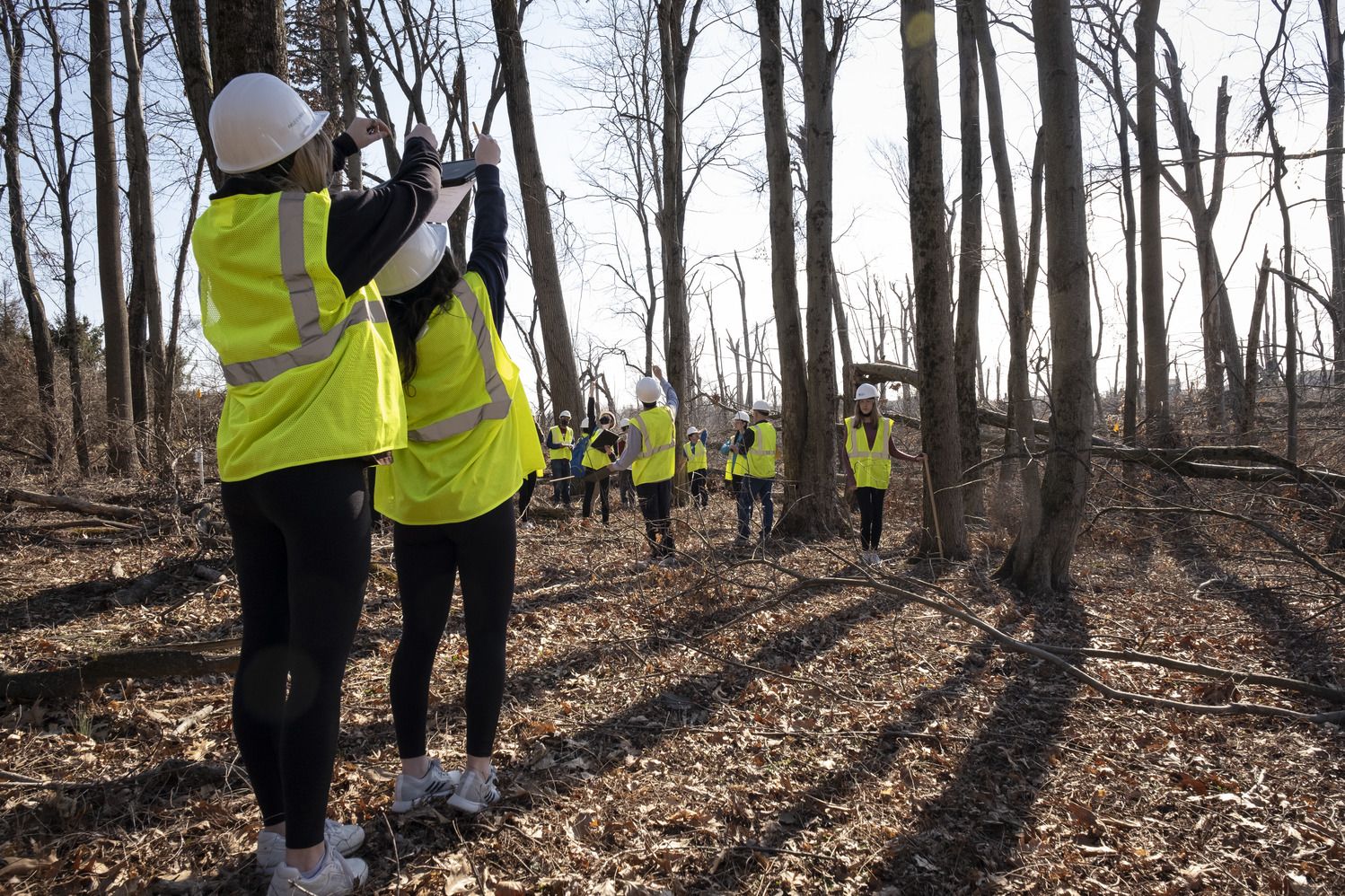

Students learned that no manipulations have been made at the Temple Forest Observatory’s community forest research site, so researchers are able to study and track the natural progression of this forest ecosystem without direct human intervention. Temple Ambler researchers established a grid of the whole forest area to facilitate systematic field data collection, so students and researchers can collect data on one square of the forest at a time.
Students learned that no manipulations have been made at the Temple Forest Observatory’s community forest research site, so researchers are able to study and track the natural progression of this forest ecosystem without direct human intervention. Temple Ambler researchers established a grid of the whole forest area to facilitate systematic field data collection, so students and researchers can collect data on one square of the forest at a time.

Students measured the height of trees at the Temple Forest Observatory’s research site.
Students measured the height of trees at the Temple Forest Observatory’s research site.
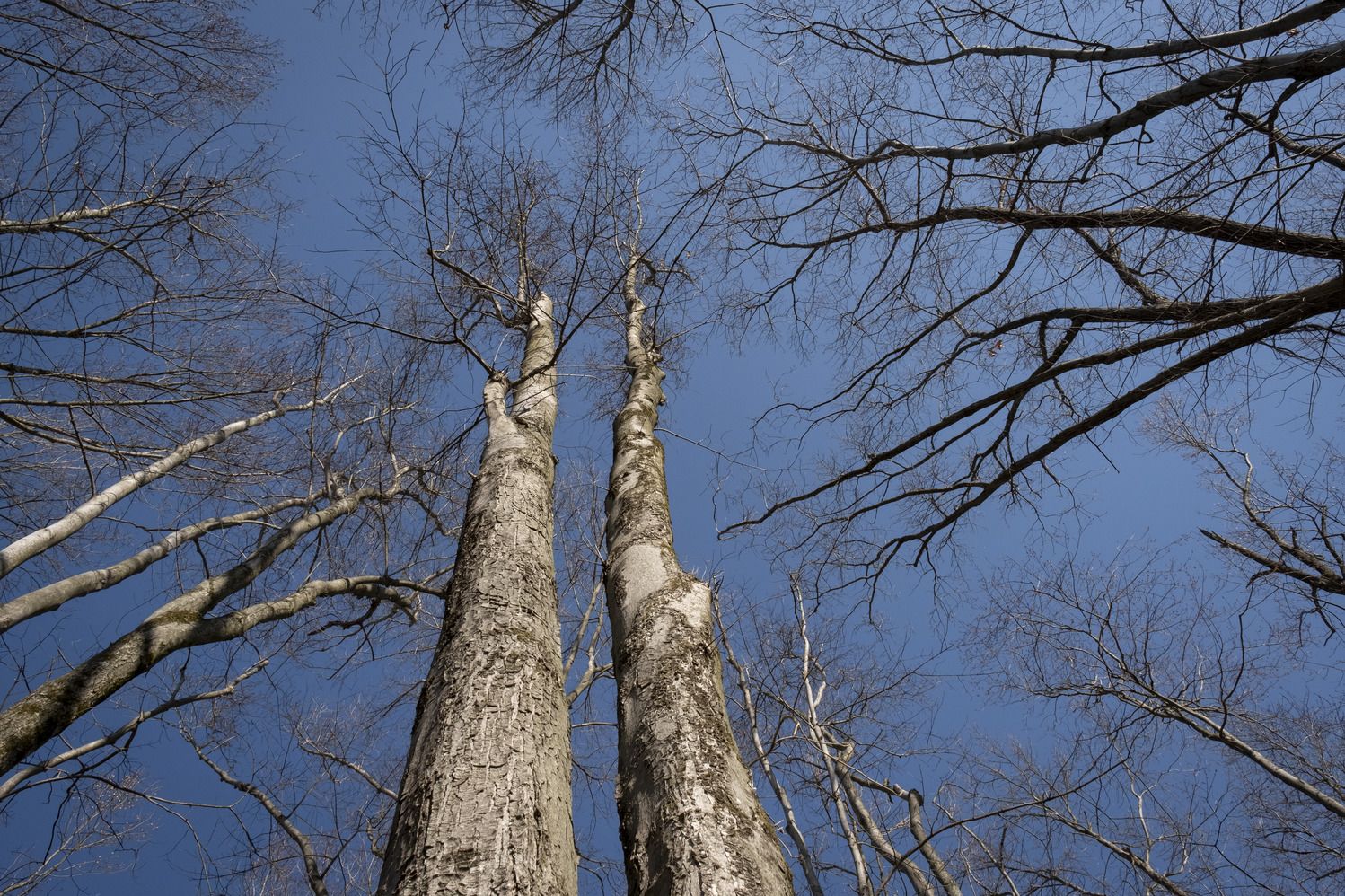
About 1,100 trees were either uprooted or damaged from the destructive climate-driven disturbance of the tornado. Some of the TFO’s biggest trees—a 140.6 cm in diameter tulip poplar and a 35 m-high red oak—fell from their roots and were lost after an EF2-level tornado from Hurricane Ida hit Temple Ambler on Sept. 1, 2021.
About 1,100 trees were either uprooted or damaged from the destructive climate-driven disturbance of the tornado. Some of the TFO’s biggest trees—a 140.6 cm in diameter tulip poplar and a 35 m-high red oak—fell from their roots and were lost after an EF2-level tornado from Hurricane Ida hit Temple Ambler on Sept. 1, 2021.
The Bioblitz forest trails
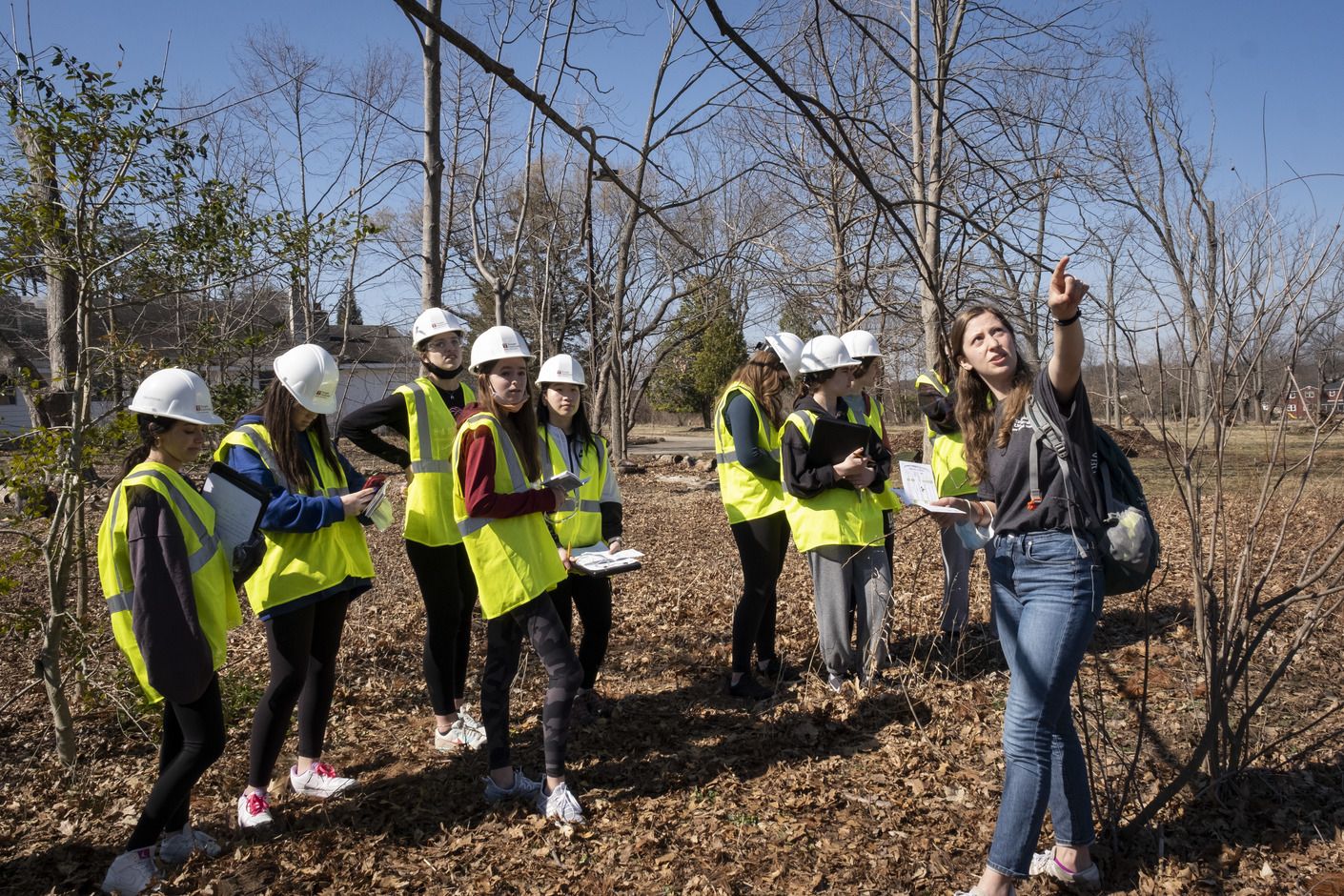
The Bioblitz forest trails
When walking through the Bioblitz forest trails on campus, the students learned techniques to identify deciduous tree species based on a set of twig characteristics and incorporate that information to the diversity database for the Ambler Field Station. Deciduous trees are notable because they change in appearance during the four seasons from losing their leaves in the fall and winter to growing new leaves, seeds and fruits in the spring and summer.
To determine a tree’s species, the groups learned about the anatomy of twigs, and followed a set of characteristics unique to each tree that can be identified even without leaves. The students were able to confirm identifications by matching the observed twig to the illustrations from the Winter Tree Finder pocket guide.
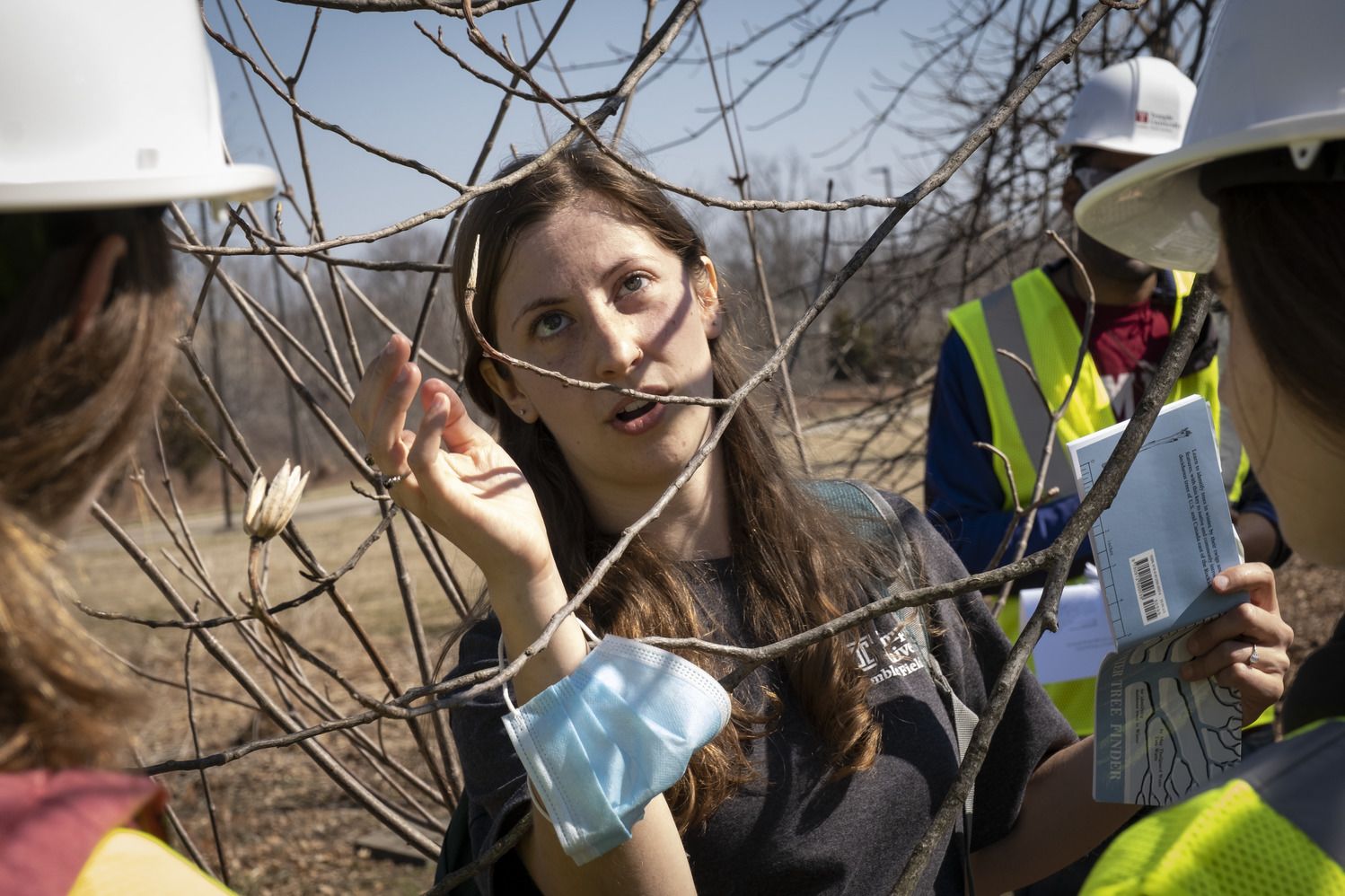
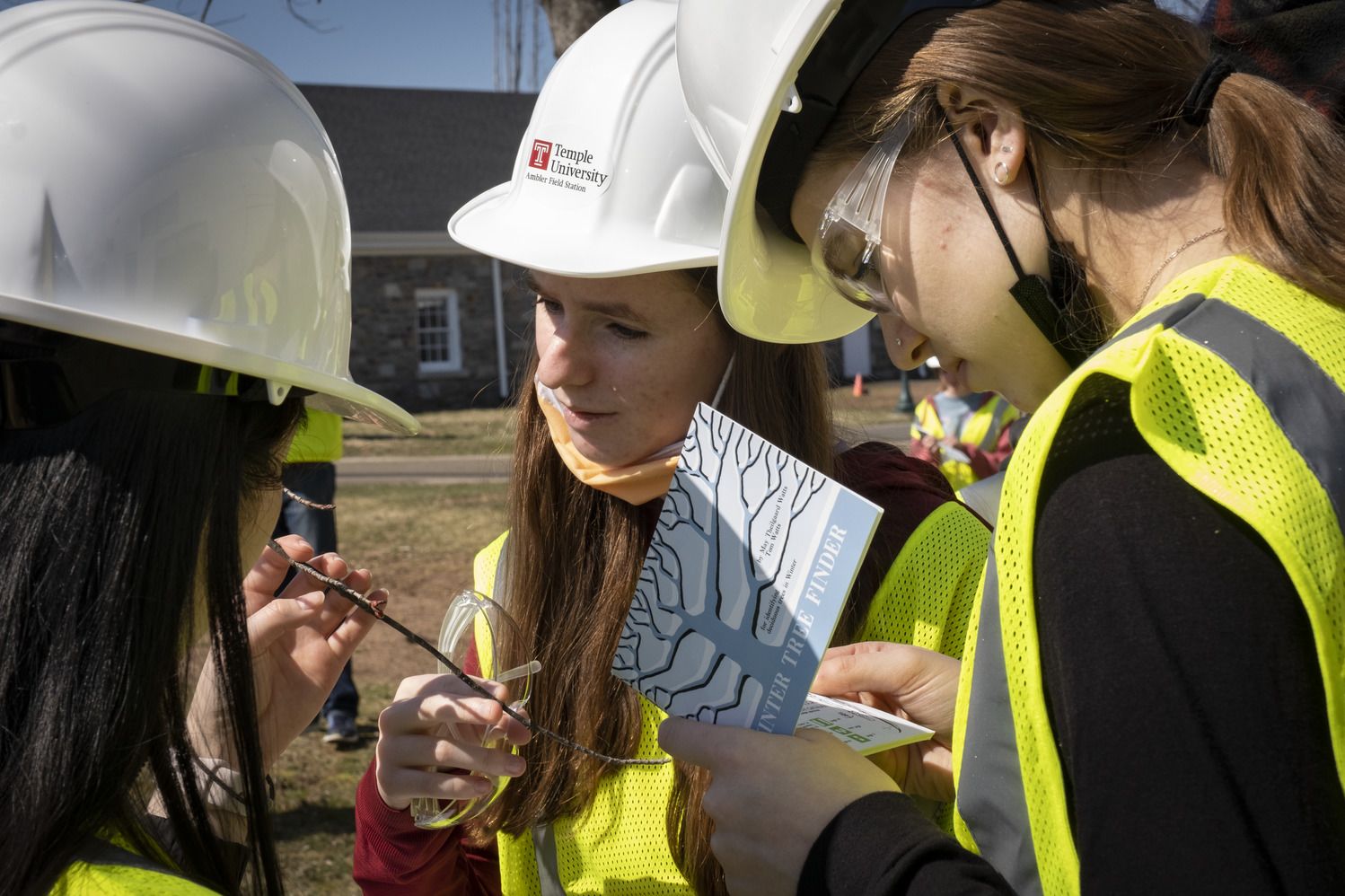
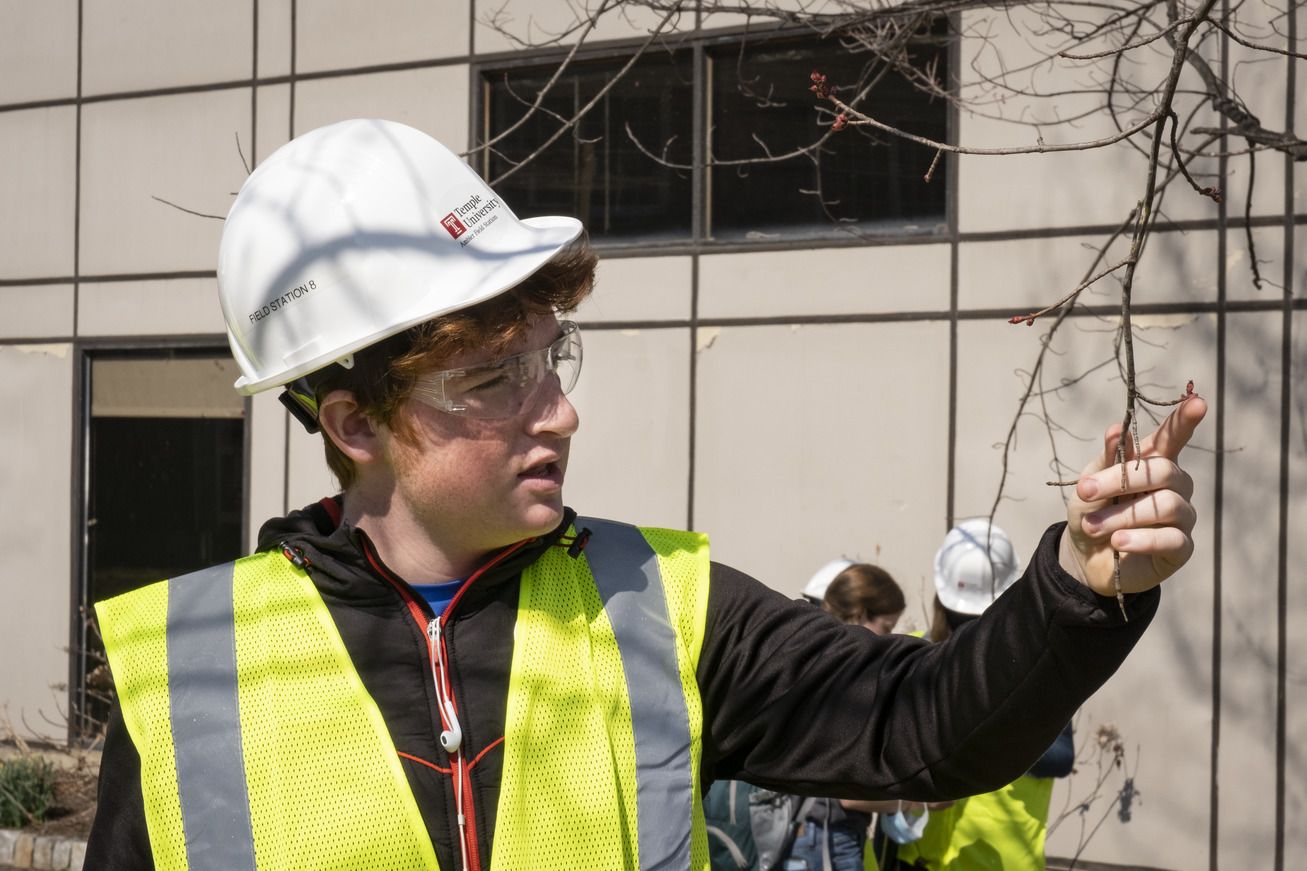
Students observed parts of a twig from the tree they wanted to identify and used illustrations from the Winter Tree Finder pocket guide to determine the tree’s species.
Mary Cortese (pictured on the right), a graduate research assistant at the Ambler Field Station, lectured the students on the diversity of native trees on Ambler’s campus through winter tree identification of dominant species.
Spotted lanternfly egg
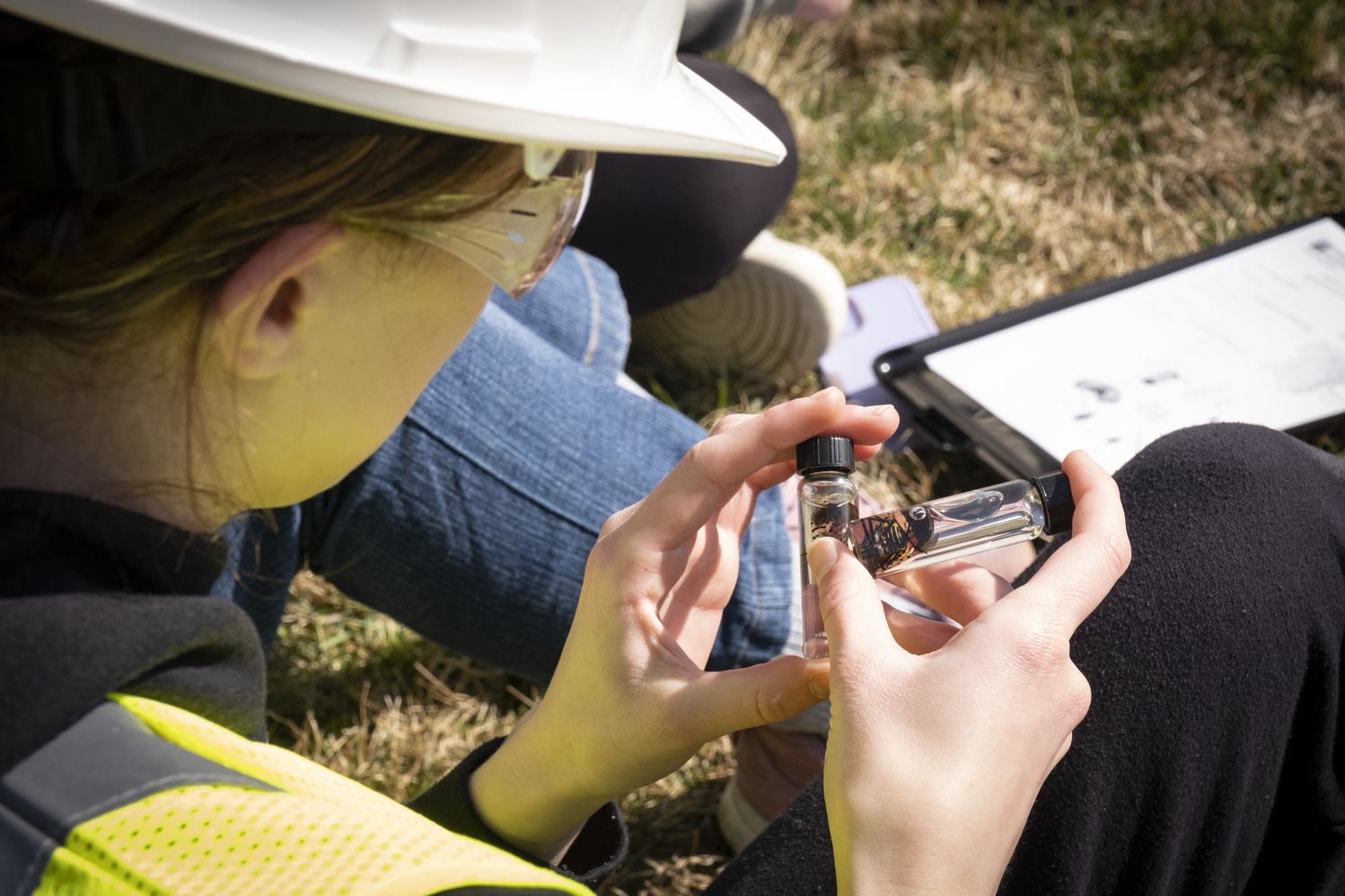
Spotted lanternfly egg
You may have already come across thousands of spotted lanternflies on campus and wondered how they arrived in the U.S. The spotted lanternfly is a planthopper native to China that originally arrived in the U.S. from egg masses attached to a shipment of stone that was first detected in Berks County, Pennsylvania, in 2014. Bonfim said the planthopper continues to spread across different parts of the Eastern United States.
“It is a feracious plant feeder that causes economic damage to vineyards, orchards and the hardwood industry, among other impacts,” she explained. “So we are trying to study these invasive species dynamics from how they spread and can be controlled.”
The students learned about the spotted lanternfly’s life cycle and egg laying behavior, identifying new and old egg masses from an individual tree on campus. Also, the students collected data on the tree, including the species, egg mass location (bark and limbs) and substrate type, the surface where an organism, such as a plant, fungus or animal lives.

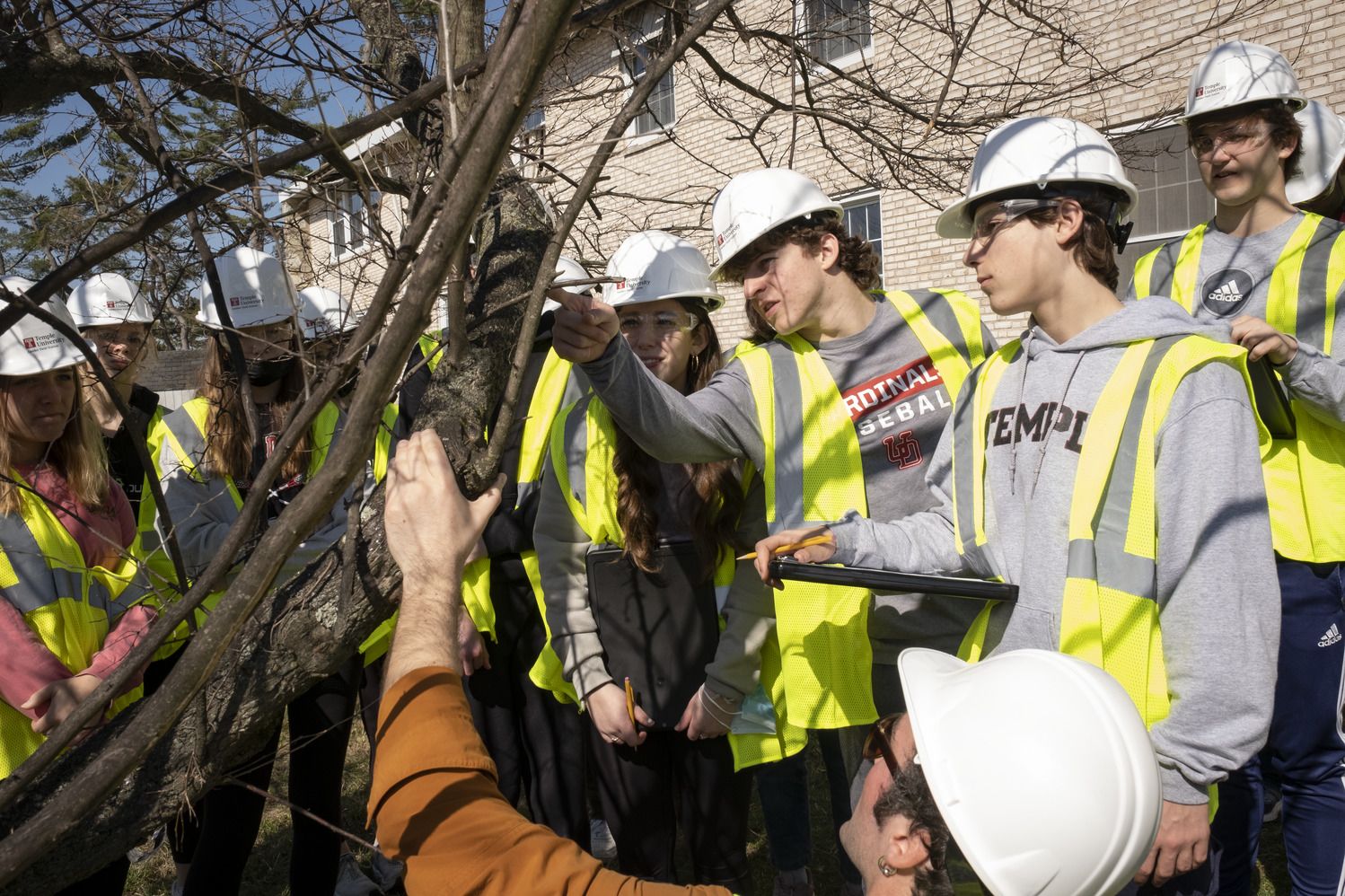
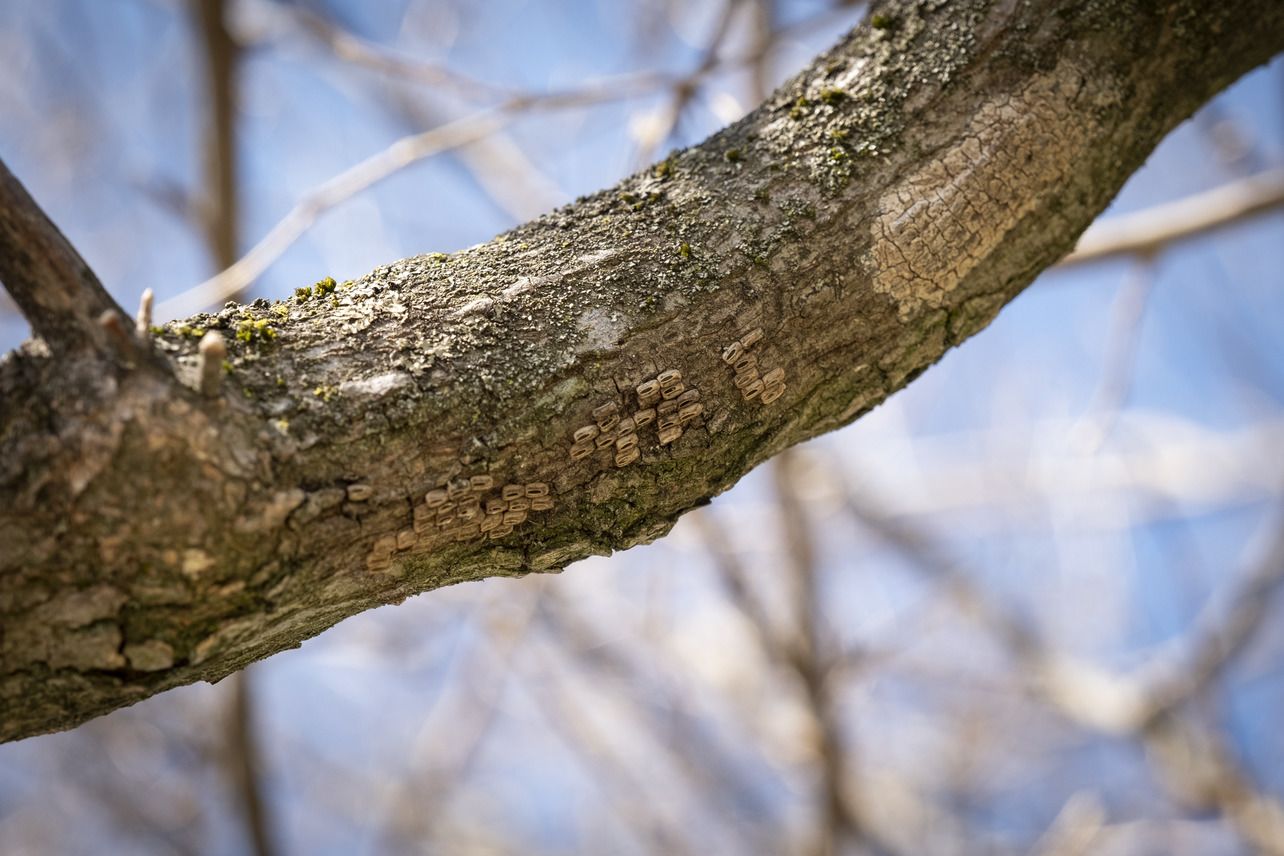
The students learned that the spotted lanternfly’s life cycle consists of egg laying, four instars, the development stages of an insect after hatching from the egg and adulthood, where they develop wings to fly. For educational purposes, the Field Station maintains a collection of jars that contain preserved spotted lanternfly specimens from each period in the insect’s life cycle.
Christopher LeClair (pictured in the center), a research technician at the Ambler Field Station, lectured the students about the spotted lanternfly’s impact on campus.
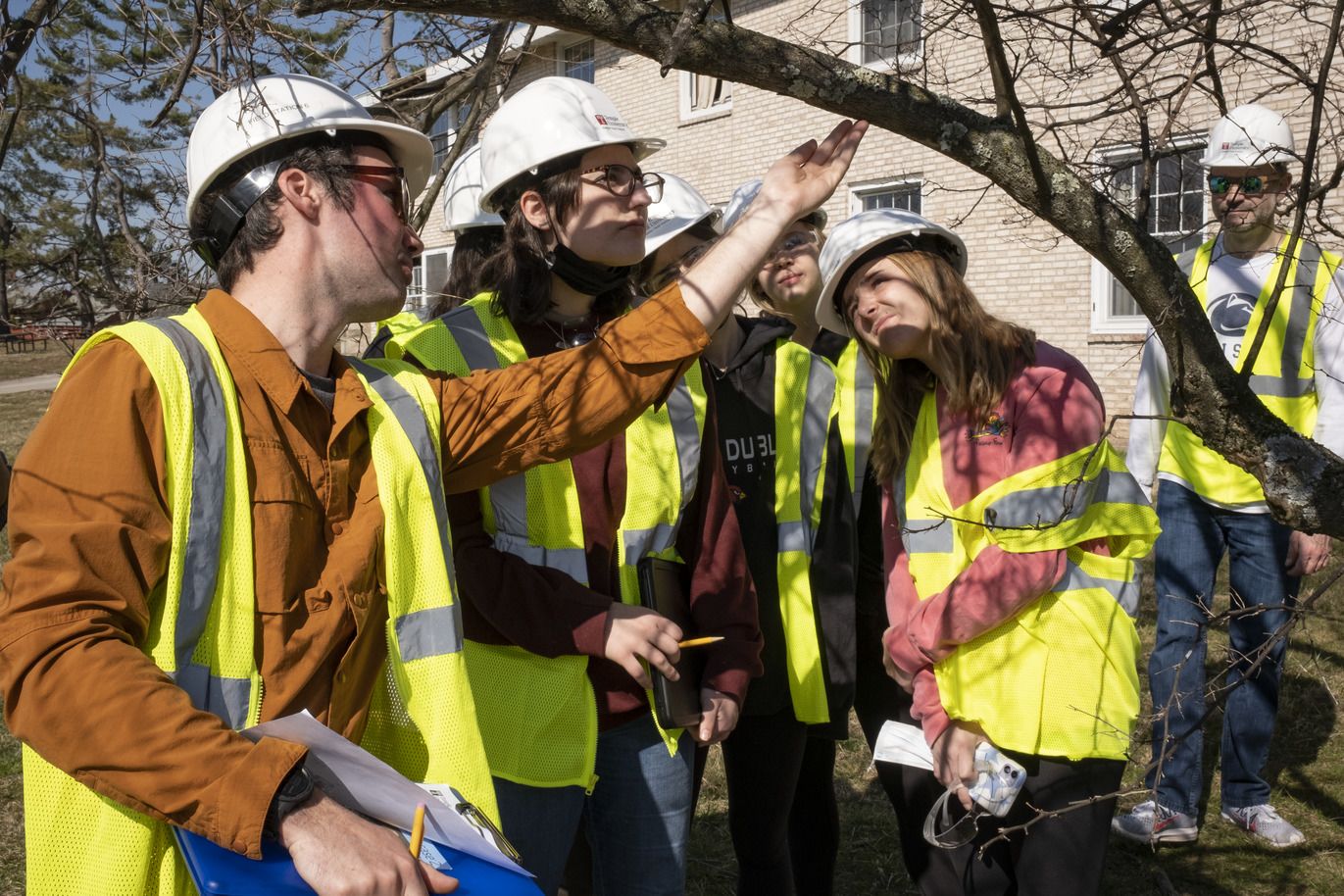
The tree species pictured here is a Japanese snowbell (Styrax japonicus), a deciduous flowering tree native to Japan that the spotted lanternfly uses as a source of food by feeding on the sap in trunks, branches and twigs.
The tree species pictured here is a Japanese snowbell (Styrax japonicus), a deciduous flowering tree native to Japan that the spotted lanternfly uses as a source of food by feeding on the sap in trunks, branches and twigs.
Researchers estimate that there are 30–50 eggs on average in each of these spotted lanternfly egg masses, which are protected with a gray putty-like covering. The Field Station data estimates that over 1000 spotted lanternfly eggs were hatched from this individual tree that the students did research on during their trip to Ambler.
Bonfim said Temple Ambler is an asset that can offer opportunities for students in the Philadelphia region and hopes it will help diversify environmental sciences and forest ecology.
“Seeing people from different backgrounds, nationalities, ethnicities being able to engage in science and connect to nature can trigger transformation,” she said.
For more information about the Ambler Field Station visit: ambler.temple.edu/FieldStation and follow their Instagram and Twitter pages.
